1938 marked the first year for the new design of the 5-cent piece in the US. This year, the Jefferson nickel was born. Since this coin is already old, many coin enthusiasts would love to add it to their collection. In this article, you will learn more about the value, composition, and historical significance of the 1938 Jefferson nickel.
What Is the 1938 Jefferson Nickel Made Of?
The 1938 Jefferson nickel is made of 75% copper and 25% nickel. This is the same composition used from 1938 until now, except from mid-1942 to 1945. During this time, the Jefferson nickel was called the “Wartime nickel.” Its composition consisted of 56% copper, 35% silver, and 9% manganese.
Now, you might wonder why the US Mint changed the composition of the nickels from 1942 to 1945. The answer is because of the war. Since nickel was an important raw material in producing weapons during World War II, Congress mandated the US Mint to look for other metals.
Thankfully, the Allied Forces won, and the nickel was restored to its original composition after the war.
When it comes to design, the Jefferson nickel features the bust of Thomas Jefferson, the third president of the United States and one of the nation’s founding fathers.
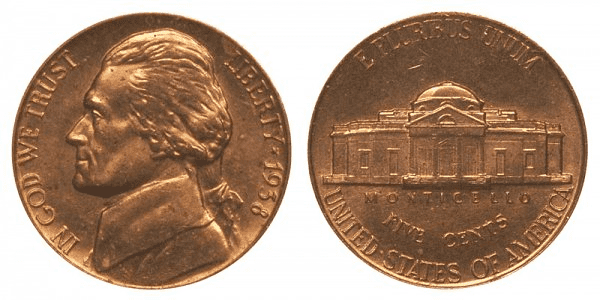
Aside from that, the obverse also features inscriptions that include the following:
- IN GOD WE TRUST
- LIBERTY
- 1938
On the reverse, you’ll find the Monticello Mansion, also Thomas Jefferson’s residence. Inscriptions include the following:
- E PLURIBUS UNUM
- MONTICELLO
- FIVE CENTS
- UNITED STATES OF AMERICA
The US Mint had been planning to replace the Buffalo nickel. While the Buffalo nickel looked nice and impressive, it was difficult to produce. The Mint needed to replace and repair the die more often than it should.
However, since the law mandated that a coin design be minted for at least 25 years, the US Mint needed to wait, and in 1938, the Jefferson nickel went through production.
From 1938 to 2004, the Jefferson nickel used the design made by Felix Schlag. Then in 2005, the design of Joe Fitzgerald was used. It didn’t last for long since, in the following year, Franki’s design was used instead.
1938 Jefferson Nickel Varieties
The 1938 Jefferson nickel has four official varieties released by the US Mint. These varieties aren’t different from each other. What sets them apart is the mint mark.
Those from the Denver Mint bear the D mint mark, while those from San Francisco have the S mint mark. Coins from Philadelphia don’t have any mintmarks.
Here’s a quick look at the different varieties of 1938 Jefferson nickel varieties along with their mintage figure:
| Variety | Mint Location | Mintage |
| 1938 D Jefferson Nickel | Denver | 5,376,000 |
| 1938 S Jefferson Nickel | San Francisco | 4,105,000 |
| 1938 P Jefferson Nickel | Philadelphia | 19,496,000 |
| 1938 Proof Jefferson Nickel | Philadelphia | 19,365 |
| Total | 28,996,365 |
Since this was the first year of minting for the Jefferson nickel, it’s understandable that only about 28.99 thousand 5-cent pieces were produced. Aside from that, the US Mint was still producing the Buffalo nickel in the first half of 1938. So, the production capacity was divided.
With that, here’s a deeper look at each of the 1938 varieties:
1938 D Jefferson Nickel
Edge: Plain
Mint Mark: D
Place of minting: Denver
Year of minting: 1938
Face Value: $0.05 (five cents)
Price: $2 to $3 (circulated condition)
Quantity produced: 5,376,000
Designer: Felix Schlag
Composition: 75% Copper, 25% Nickel
Mass: 5.00 grams
Diameter: 21.20 mm
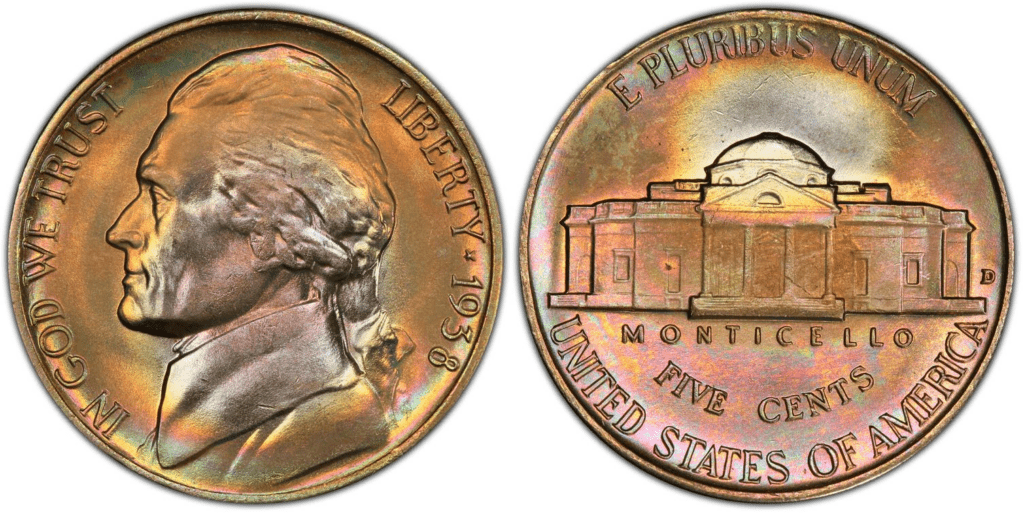
The Denver Mint produced both the Buffalo nickel and Jefferson Nickel in 1938. For this reason, there were only about 5 million nickel examples produced. Despite the low mintage of the 1938 D nickel, plenty of these coins come in a Gem state, from MS 60 to MS 66. However, only about 200 of the 1938 D nickels achieved an MS67 grade. The coin becomes scarcer in MS68 and above.
1938 S Jefferson Nickel
Edge: Plain
Mint Mark: S
Place of minting: San Francisco
Year of minting: 1938
Face Value: $0.05 (five cents)
Price: $0.11 to $3.50 (circulated condition)
Quantity produced: 4,105,000
Designer: Felix Schlag
Composition: 75% Copper, 25% Nickel
Mass: 5.00 grams
Diameter: 21.20 mm
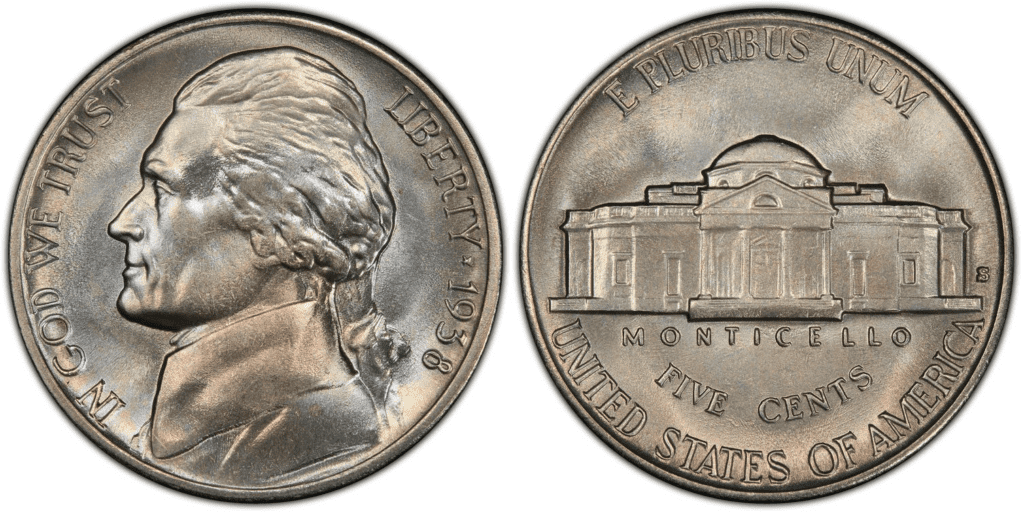
Only about 4 million 1938 S nickels were produced by the US Mint. Many speculators and collectors at that time ensured they had enough examples. So, they have saved a lot of these nickels.
Looking at the 1938 S nickel, you’ll notice that these coins have weak strikes due to the use of worn-out dies.
1938 P Jefferson Nickel
Edge: Plain
Mint Mark: no mint mark
Place of minting: Philadelphia
Year of minting: 1938
Face Value: $0.05 (five cents)
Price: $0.11 to $3 (circulated condition)
Quantity produced: 19,496,000
Designer: Felix Schlag
Composition: 75% Copper, 25% Nickel
Mass: 5.00 grams
Diameter: 21.20 mm
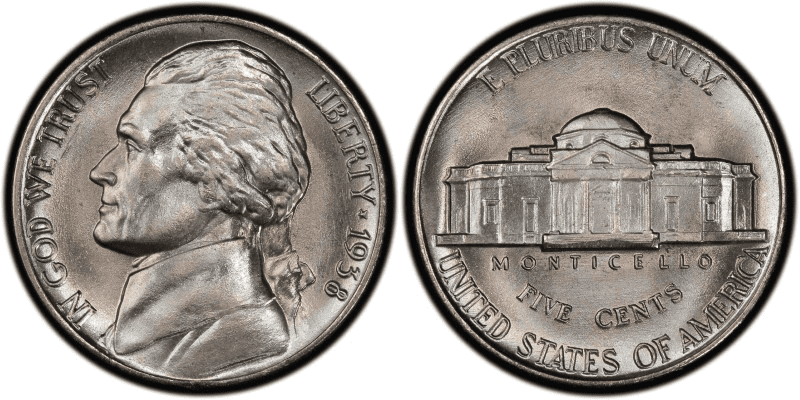
The Philadelphia Mint produced the most 1938 nickels. This is why there are more 1938 P nickels than the 1938 S and D today.
Although the mintage figure of the Philadelphia Mint is already impressive, if you compare it to the other mint centers, you would be more impressed when you know how many nickels the Philadelphia Mint produced in the following year. More than 120 million nickels produced in 1939, which dwarfed the 19-million production number in 1938.
1938 Proof Jefferson Nickel
Edge: Plain
Mint Mark: no mint mark
Place of minting: Philadelphia
Year of minting: 1938
Face Value: $0.05 (five cents)
Price: $320 or more (uncirculated condition)
Quantity produced: 19,496,000
Designer: Felix Schlag
Composition: 75% Copper, 25% Nickel
Mass: 5.00 grams
Diameter: 21.20 mm
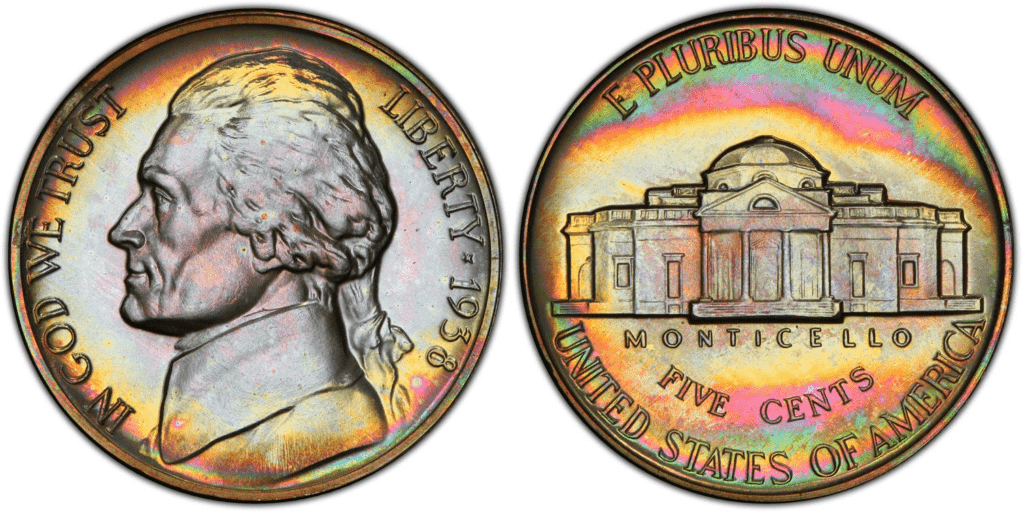
The proof coins of the 1938 Jefferson nickel are undoubtedly the most beautiful among the four varieties. Each of these coins was hand-polished and carefully struck to produce a more detailed look fully.
Today, you should be able to find 1938-proof nickels in PR64 to PR66 condition. PR67-proof nickels are difficult to find, but PR68 is the scarcest. There are no known proof nickels with a grade of PR69 to PR70.
List Of 1938 Jefferson Nickel Errors
There were almost 29 million nickels struck in 1938. With a low mintage like this, it would be difficult to find any error coins. Nevertheless, some error coins still made it out from the Mint Centers.
Perhaps, the most common error is the 1938 DDO or doubled die obverse error. This type of error happens when the die strikes the planchet twice. If the angle of the strike were a little different, you should then find a doubling in the engraved elements on the coin, usually on the letters.
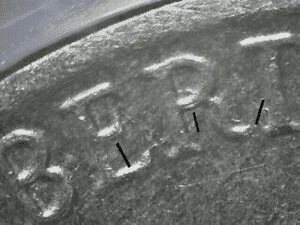
DDO is not always obvious, but it would dramatically increase its value when they do.
There are also times when the error happens during the blank coin or planchet production. One error example is a clipped or cracked coin such as this one:
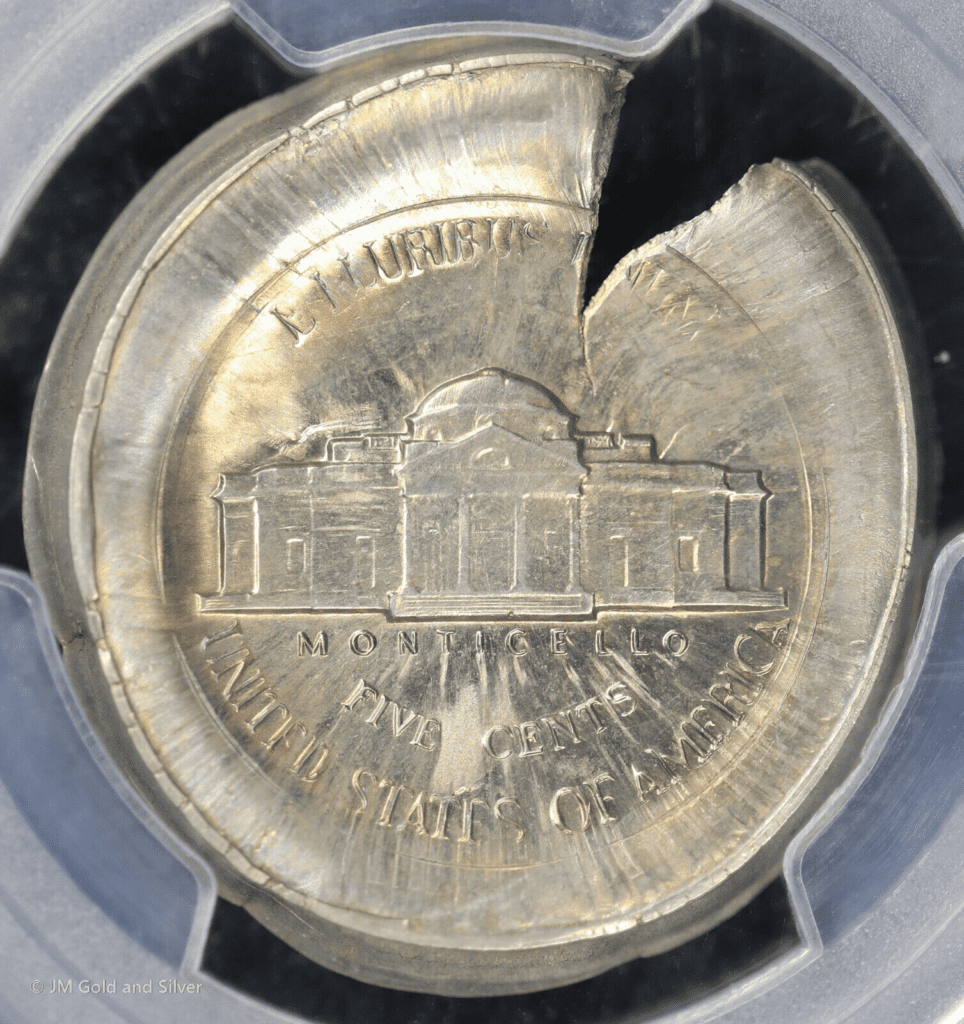
How Much Is The 1938 Jefferson Nickel Worth Today?
The Jefferson nickel has a face value of 5 cents. Its melt value isn’t significantly higher, at around $0.0707.
1938 Jefferson nickels that entered circulation are usually considered less valuable. Circulated coins can be about $1 to $4. However, uncirculated 1938 Jefferson nickels are considered to be more valuable. The price may start at $20. Proof coins are even more precious and can be sold for hundreds of dollars.
It’s worth noting that 1938 nickels have been sold for more. If you want to learn more, check out this table of auction records for each variety:
| Coin | Condition | Grade | Sold date | Sold by | Value |
| 1938 D Jefferson Nickel | Superb Gem Uncirculated | MS 68+ (Full Step) | July 17, 2022 | Heritage Auctions | $33,600 |
| 1938 S Jefferson Nickel | Superb Gem Uncirculated – Full Step | MS 67 | August 18, 2004 | Heritage Auctions | $9,200 |
| 1938 P Jefferson Nickel | Superb Gem Uncirculated – Full Steps | MS 67 | May 26, 2006 | Bowers & Merena | $8,625 |
| 1938 Proof Jefferson Nickel | Superb Gem Uncirculated | PR 67 | May 1, 2001 | Heritage Auctions | $5,980 |
How Does The Grading System Work?
The Sheldon Scale is the most common grading system used to know the condition and value of a 1938 nickel. The same grading system is used in other coins.
The appraiser would check the overall condition, appearance, color, and strike of a 1938 nickel and see where it stands on the Sheldon Scale. The highest grade based on the Sheldon Scale is 70.
Aside from that, the nickel can be considered as PR (Proof) or MS (Mint State). Proof coins are those that are made originally for collectors. MS coins are those that are made for circulation.
For proof coins, additional grading categories are used. These include Cameo and Deep Cameo. For MS nickels, they can be Full Steps or not. A Full Steps nickel has five to six visible steps on the Monticello mansion. Generally speaking, a Full Steps nickel is more valuable than those coins that don’t have this grading.
Where To Buy Or Sell 1938 Jefferson Nickel?
The 1938 Jefferson nickel is available online. The most popular place online to buy 1938 5-cent coins is eBay. You can go to eBay’s website, quickly search, and instantly find a list of 1938 Jefferson nickels for sale. You can also try other online platforms such as Amazon and Etsy.
Aside from online, you can try coin shops and antique shops. If you have the opportunity, you can join auctions, a good place to buy or sell 1938 Jefferson nickels.
FAQs
Is a 1938 nickel made of silver?
No, the 1938 nickel is not made of silver. It is rather made of 75% copper and 25 nickel.
Where is the mint mark on a 1938 nickel?
The mint mark on a 1938 nickel is on the coin’s reverse side. Look for it between the right side of the Monticello and the rim. You should find a D for Denver Mint or S for San Francisco. If not, then the coin is from Philadelphia.
